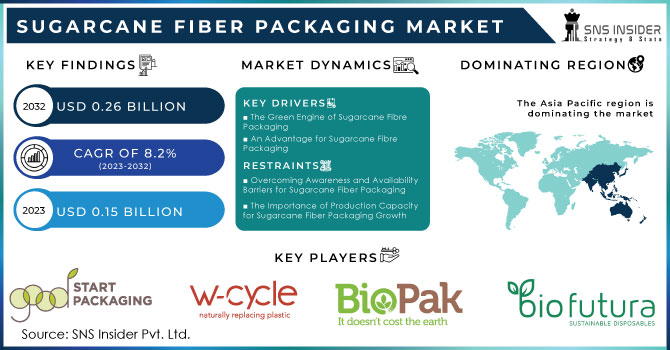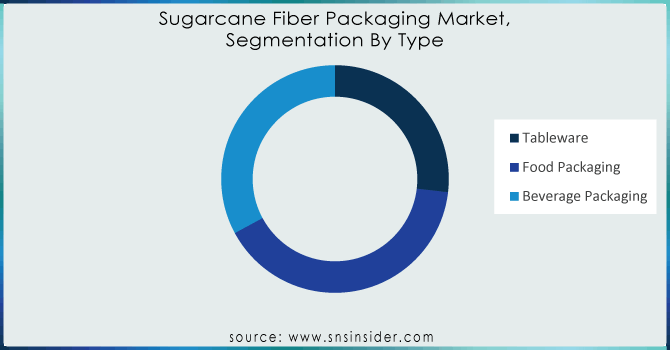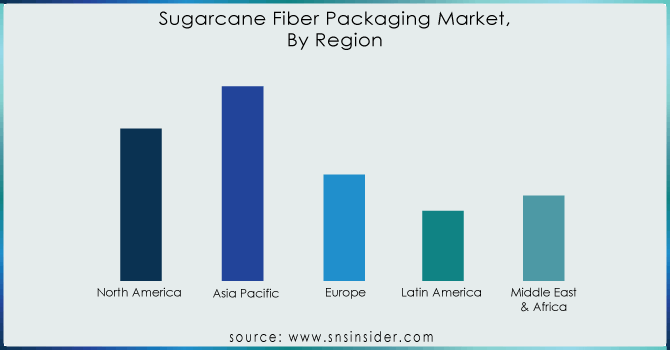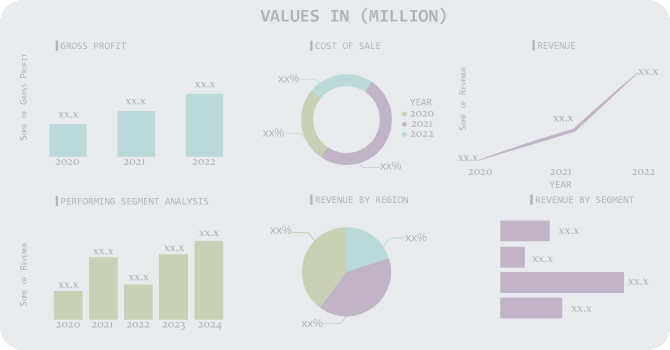Market Report Scope & Overview

Get More Information on Sugarcane Fiber Packaging Market - Request Sample Report
The Sugarcane Fiber Packaging Market was Valued at USD 0.15 Billion in 2023 and is now anticipated to grow to USD 0.26 Billion by 2032, displaying a compound annual growth rate (CAGR) 5.66 % of during the forecast Period 2024 - 2032.
The sugarcane fibre packaging market is driven by a confluence of factors. Consumers are increasingly environmentally conscious, seeking out sustainable solutions in all aspects of their lives, including packaging. Governments around the world are enacting stricter regulations on single-use plastics, further pushing businesses towards eco-friendly alternatives. Sugarcane fibre steps in to meet these demands, offering comparable functionality to traditional options. It can withstand heat, grease, and moisture, making it suitable for a wide range of food and beverage applications. From takeout containers and plates to cups and trays, sugarcane fibre packaging provides a sustainable option without compromising on performance.
Sugarcane fibre packaging is emerging as a game-changer in the packaging industry, offering a sustainable and eco-friendly solution for a wide range of needs. This innovative material, also known as bagasse, is a byproduct of the sugarcane industry, utilizing the leftover fibrous residue after juice extraction. Fueled by the growing emphasis on environmental responsibility and reducing plastic waste, the sugarcane fibre packaging market has seen significant growth. Consumers and businesses alike are driving this demand, seeking eco-friendly alternatives to traditional packaging materials. From food and beverage giants to healthcare and cosmetics companies, even consumer goods manufacturers are embracing sugarcane fibre packaging. This market is further fueled by continuous advancements from key players who are actively investing in research and development to improve the performance and versatility of these products. The process involves transforming sugarcane fibres into a usable material for packaging creation. These processed fibres are then molded into various shapes and sizes, resulting in a diverse range of products including trays, containers, plates, cups, and many more.
When compared to traditional plastic and paper-based packaging that adds to landfill garbage, sugarcane fibre packaging is aesthetically pleasing due to its biodegradability and compo stability. The market for sugarcane fibre packaging is expected to develop because to its eco-friendliness and rising consumer demand, which will open the door for a more sustainable future for the packaging sector.
Market Dynamics
Drivers
The Green Engine of Sugarcane Fibre Packaging
The global Sugarcane Fibre packaging business is transitioning to more sustainable processes, and it is emerging as a leader in this trend, owing to its eco-friendliness. Traditional packaging materials that linger in landfills for years, sugarcane fibre boasts impressive sustainability advantages. Derived from bagasse, a fibrous byproduct of sugarcane processing, sugarcane fibre is a renewable reType . This means it can be replenished at a rapid pace, unlike plastic derived from fossil fuels. Even more compelling is its biodegradability and compostability. Plastic that breaks down into harmful micro plastics, sugarcane fibre decomposes naturally, leaving behind no harmful residues. This significantly reduces environmental impact and contributes to a healthier planet. Sugarcane fibre packaging offers a viable solution that aligns with these values.
An Advantage for Sugarcane Fibre Packaging
Governments around the world are enacting stronger restrictions to combat single-use plastics. This regulation presents a dilemma for enterprises that have long relied on plastic packaging. It gives an excellent opportunity for the sugarcane fibre packaging business. These restrictions essentially force businesses to embrace environmentally friendly alternatives, and sugarcane fibre stands out as a feasible and sustainable option. Businesses that use sugarcane fibre packaging can ensure regulatory compliance and avoid potential penalties. Reduces legal concerns, but also indicates a commitment to environmental responsibility, which may improve their brand image and attract environmentally concerned customers. The regulatory landscape is continually changing, and sugarcane fibre packaging provides a future-proof solution that precisely coincides with the growing emphasis on sustainability. Sugarcane fibre packaging has evolved as a sustainable option for takeout containers, plates, and cups. The market is experiencing extraordinary growth into new territories. Consider environmentally friendly packaging for your favorite lotions, creams, and shampoos! This transition corresponds to rising consumer demand for sustainable beauty solutions. Consumer goods packaging is also taking notice. Sugarcane fibre is being examined for a number of applications, including electronics and toys. This larger applicability allows for a more complete and meaningful approach to sustainable packaging across multiple industries. The future of packaging is looking greener, and sugarcane fibre is set to play a key role in that change.
Restraints
Overcoming Awareness and Availability Barriers for Sugarcane Fiber Packaging
Sugarcane fibre packaging provides a tempting alternative for sustainable packaging, but two major barriers to its wider adoption are limited awareness and availability. Highlighting the environmental benefits of sugarcane fibre compared to traditional packaging can encourage consumers to seek out products with this sustainable option. Availability also presents a challenge. Sugarcane fibre packaging might not be readily available in all regions, especially those with less developed distribution networks. Strengthening these networks is essential to ensure consumers have access to this sustainable choice.
The Importance of Production Capacity for Sugarcane Fiber Packaging Growth
Keeping up with the increasing demand for sugarcane fibre packaging poses an exciting challenge in terms of production capacity. Supply restrictions can appear as the market grows. An essential first step in addressing this is to expand production facilities. Purchasing additional manufacturing facilities will boost sugarcane fibre packaging production satisfying the expanding demands of both consumers and enterprises. Reducing the number of moving parts in current industrial processes can boost productivity and maximize efficiency without requiring major infrastructure modifications. The sugarcane fibre packaging market may capitalize on the rising demand for eco-friendly packaging solutions while ensuring a seamless transition towards a more sustainable future by concentrating on these areas and preventing supply disruptions.
Segmentation Analysis
By Type
-
Tableware
-
Food Packaging
-
Beverage Packaging
Food packaging, with its unparalleled adaptability, is the dominant segment in the sugarcane fibre industry due to its shape-changing properties, sugarcane fibre is the preferred option for a wide range of food products. It meets a variety of demands with its sizzling hot takeout containers, fresh fruit trays, and bakery boxes. Another important asset is functionality while Sugarcane fibre ensures food safety and quality by outperforming conventional materials like plastic and polystyrene in terms of resistance to heat, grease, and moisture. The fact that sugarcane fibre satisfies consumer desire for environmentally friendly products is perhaps its greatest advantage. It is the sustainable leader in food packaging because of its capacity to decompose and biodegrade, which reduces its negative effects on the environment.

Need any customization research on Sugarcane Fiber Packaging Market - Enquiry Now
By Application
-
Fresh Food
-
Dry And Frozen Food
-
Meat Products
-
Dairy Products
-
Bakery Products
-
Beverage
The market for Fresh Food in sugarcane fibre packaging is dominated. In contrast to conventional solutions, sugarcane fibre regulates moisture and permits air circulation, which is essential for maintaining the freshness of fruits, vegetables, and other perishables. Longer shelf lives, less food waste, and perfect synchronization with customer preferences. Sugarcane fibre emerges as the front-runner for fresh food packaging as sustainability gains prominence, providing a mutually beneficial solution for consumers and the environment.
By Manufacturing
-
Make -to- order Manufacturing
-
Make-to -Stock Manufacturing
Regional Coverage
North America
-
US
-
Canada
-
Mexico
Europe
-
Eastern Europe
-
Poland
-
Romania
-
Hungary
-
Turkey
-
Rest of Eastern Europe
-
-
Western Europe
-
Germany
-
France
-
UK
-
Italy
-
Spain
-
Netherlands
-
Switzerland
-
Austria
-
Rest of Western Europe
-
Asia Pacific
-
China
-
India
-
Japan
-
South Korea
-
Vietnam
-
Singapore
-
Australia
-
Rest of Asia Pacific
Middle East & Africa
-
Middle East
-
UAE
-
Egypt
-
Saudi Arabia
-
Qatar
-
Rest of the Middle East
-
-
Africa
-
Nigeria
-
South Africa
-
Rest of Africa
-
Latin America
-
Brazil
-
Argentina
-
Colombia
-
Rest of Latin America
Regional Analysis
Asia-Pacific area driving a convergence of forces to dominate the sugarcane fibre packaging market due to increasing demand for eco-friendly packaging solutions is created by Asia Pacific's large population and growing consumer concern about environmental issues, which is pushing consumers toward sustainable options. Regulations imposed by the regional governments on single-use plastics are also contributing to the adoption of alternatives such as sugarcane fibre by enterprises. The prompt availability and affordability of these eco-friendly packaging materials are further ensured by a robust production base in Asia Pacific. Asia Pacific has the top spot in the sugarcane fibre packaging market at the moment due to a number of factors.
North America Sugarcane fibre packaging is seeing a green rise Customers are requesting sustainable options as they become more environmentally concerned. The government's policies that are in favor of this shift in consumer preferences have created an ideal environment for the market's explosive growth. North American customers are actively looking for eco-friendly packaging choices as they become more conscious of their environmental impact. Government policies are changing to support sustainable alternatives in order to meet this need. These elements working together are driving the sugarcane fibre packaging market in North America and establishing the region as one with enormous growth potential.
Europe is leading the way in the transition to a greener future with packaging made of sugarcane fibre. Businesses are being forced to reconsider their packaging tactics due to strict plastic rules, and sugarcane fibre is an ideal fit because it emphasizes sustainability. Businesses are responding to the eco-consciousness of European consumers by providing sustainable solutions. Regulations forcing them to move away from conventional plastics and a populace favoring environmentally friendly options mean that the European sugarcane fibre packaging industry is expected to grow significantly. In addition to being beneficial for the environment, this turn toward sustainability places European companies at the forefront of the worldwide push for ethical packaging techniques.
Latin America and the Middle East & Africa are about to witness a revolution in sustainable packaging using sugarcane fibre. Despite being regarded as emerging markets, these areas should see rapid growth as a result of increased public awareness of environmental issues. With rising disposable budgets, buyers are growing pickier and more interested in eco-friendly products. This is making the climate more conducive to the spread of sugarcane fibre packaging, along with rising environmental consciousness. These regions' governments will probably follow suit and enact laws that support sustainability, hastening the use of environmentally friendly packaging materials like sugarcane fibre.

Key Players
Some of the major Key Players are Good Start Packaging, Pappco Greenware – Beriwal International, W-cycle, Biopak, Biofutura B.V., Vegware Ltd., Dart Container Corporation, Visfortec Pvt. Ltd., Eco-Products, Inc, Geotegrity, Inc, Detpak India Pvt. Ltd.
Good Start Packaging-Company Financial Analysis

Recent Development
Recent Innovations in Sugarcane Fiber Packaging (June 2024)
-
Huhtamaki (Finland) collaborated with Danone (France) to create a novel yogurt cup composed of sugarcane fibre and a bio-based barrier, which eliminates the need for typical plastic lining. This innovation improves the cup's recyclability and lowers its environmental footprint.
-
Vegware (US) introduced a new line of dishwasher-safe sugarcane fibre plates, bowls, and containers. This breakthrough broadens the use of sugarcane fibre packaging beyond single-use solutions, addressing reusability requirements in restaurants and families.
-
PackTiger (China) has introduced a novel sugarcane fibre thermoforming technology, which enables the fabrication of thinner and lighter packaging choices. This invention saves material usage and decreases the overall carbon footprint of the package.
| Report Attributes | Details |
|---|---|
| Market Size in 2023 | US$ 0.15 Billion |
| Market Size by 2031 | US$ 0.26 Billion |
| CAGR | CAGR of 5.66 % From 2024 to 2032 |
| Base Year | 2023 |
| Forecast Period | 2024-2031 |
| Historical Data | 2020-2022 |
| Report Scope & Coverage | Market Size, Segments Analysis, Competitive Landscape, Regional Analysis, DROC & SWOT Analysis, Forecast Outlook |
| Key Segments |
• By Type (Tableware, Food Packaging)
|
| Regional Analysis/Coverage | North America (US, Canada, Mexico), Europe (Eastern Europe [Poland, Romania, Hungary, Turkey, Rest of Eastern Europe] Western Europe] Germany, France, UK, Italy, Spain, Netherlands, Switzerland, Austria, Rest of Western Europe]), Asia Pacific (China, India, Japan, South Korea, Vietnam, Singapore, Australia, Rest of Asia Pacific), Middle East & Africa (Middle East [UAE, Egypt, Saudi Arabia, Qatar, Rest of Middle East], Africa [Nigeria, South Africa, Rest of Africa], Latin America (Brazil, Argentina, Colombia, Rest of Latin America) |
| Company Profiles | Good Start Packaging, Pappco Greenware – Beriwal International, W-cycle, Biopak, Biofutura B.V., Vegware Ltd., Dart Container Corporation, Visfortec Pvt. Ltd., Eco-Products, Inc, Geotegrity, Inc, Detpak India Pvt. Ltd. |
| Key Drivers | • The Green Engine of Sugarcane Fibre Packaging • An Advantage for Sugarcane Fibre Packaging |
| RESTRAINTS | • Overcoming Awareness and Availability Barriers for Sugarcane Fiber Packaging • The Importance of Production Capacity for Sugarcane Fiber Packaging Growth |

